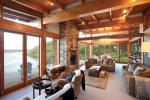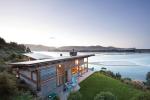Kaimata Retreat A decade in the news

Ten years after it was designed and built, Kaimata Retreat has brought architect Will Lewis of Lewis Architecture, Dunedin, yet more accolades with his joint-winning of the Colin Stanley People’s Choice Memorial Award at the 2014 ADNZ/ Resene Architectural Design Awards and the Highly Commended citation in the ADNZ 2014 Otago/Southland Residential Interiors.
Will is the first to acknowledge Kaimata Retreat’s superb location is a significant factor in attracting universal admiration. But it’s the sensitivity of his design as it beds into the landscape that continues to win recognition.
The lodge sits in five acres of coastal land overlooking the Papanui Inlet and affording panoramic views from every window – except these are more than just ordinary ‘windows’: much of the north-facing wall comprises in-fill panels of cladding and floor-to-ceiling glass, set within post-and-beam exposed construction from Macrocarpa timber harvested from the property.
In every project where views are a feature, Will begins by considering how the naturally beautiful surrounds will look from the inside of the building and in his design aims to position every part of the building to take advantage of the view and thus give rhythm to his architecture.
His aim with Kaimata Retreat was to maximise visibility of this spectacular natural landscape by bringing the view into the house so that residents feel they are living within, and are part of, the landscape rather than just admiring it when they go outside.
Critical to the overall project was the time Will spent on the design and its interaction with its surrounds. He visited the site in the morning, at midday and in the evening before he began design sketches. In this way he could take into account sun angles and the time of the day that different spaces in the house would be used while also considering the orientation of the structure to ensure the main view was in focus while unwanted views were obscured by strategic positioning of walls, columns and doors.
Although Kaimata Retreat was Will’s first independently commissioned design, which he developed while still a student in his final year of Architecture School in Auckland, he was well equipped to take on the challenge, having always been inclined to environmentally sustainable architecture.
More significantly, Will was familiar with the area – and the terrain. He owned the land next door to the client who, knowing his situation, invited him to create a building that suited their specific requirements. His brief included using non-toxic materials and incorporating the macrocarpa timber from the site. The client also wanted to be able to see the structure. For his part, as a fan of the passive design philosophy, Will wanted to see the house fitting into its surroundings rather than sticking out on the landscape.
It was a design Will found both challenging and rewarding. Juxta-positioning the project with his architectural studies, he took one year to develop the drawings. Then followed a further two for the build and another two before the landscaping and plantings were complete. The clients then waited a few more years for the native planting to develop before commissioning a photographer to capture the wairua, or ‘spiritualness’ of Kaimata Retreat.
Using common architectural principles Will designed the width of rooms based on where the sun went in winter and where it would fall on the eaves. To maximise passive energy he incorporated extra-wide eaves; harnessed the sun from stone and concrete materials; installed quality insulation and added double-glazing and underfloor heating. He positioned doors to open onto expansive wooden decks with wide-sweeping views over the inlet to the horizon beyond. He exposed the beams which support the walls and roof and made them a design feature of both the exterior and the stylish interior. His choice of longrun metal roofing accommodated the owners’ delight in the sound of rain-on-the-roof as they hunker down over winter. His finishing touches, inside and out, included local volcanic stonework sourced from the peninsula and exterior weatherboard cladding left to weather. And the property collects roof water and recycles waste water on site, making it almost self-sufficient.
No wonder the ADNZ judges were impressed by this ‘naturally conceived’ project: “Heavy timbers and natural materials give this interior the feel of a quintessential country lodge. Solid walls, generous spaces and textured materials create a comfortable retreat in a wild natural setting.”
Kaimata Retreat owners Kyle Davidson and Rachel Duell are also impressed. They have thoughtfully developed the aesthetic and ecological appeal of this lodge. Their planting programme continues to progress and now includes a variety of native flora, a ten-year-old orchard and a burgeoning kitchen garden. Their aim of meeting, and more than satisfying, the growing eco-tourism demand grows apace, providing guests with quick access to wildlife tourism along with awe-inspiring views across the 350ha estuary which teems with coastal birds and wild life, like the Royal Albatross and the endangered hoiho, the Yellow-eyed penguin.
The luxury eco-retreat offers three guest rooms and not unexpectedly, each room has been named after a local bird. There’s Kahu and the smaller Kotare, both protected native birds, and there’s Korimako, the spirit bird of the Maori people.
With its culturally sensitive, aesthetic and ecological appeal Kaimata Retreat’s benign footprint scarcely impacts on the environment and thus both honours its Maori heritage and reflects architect Will Lewis’s philosophy of creating environmentally sustainable architecture.



